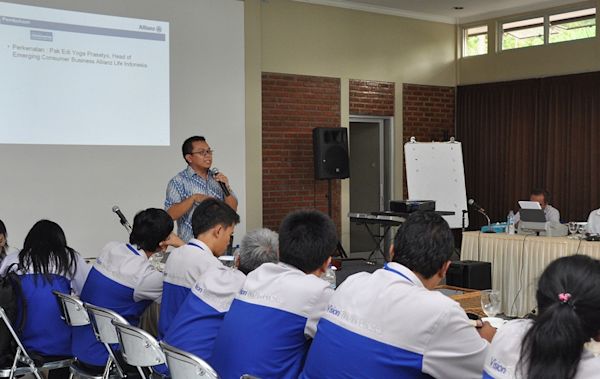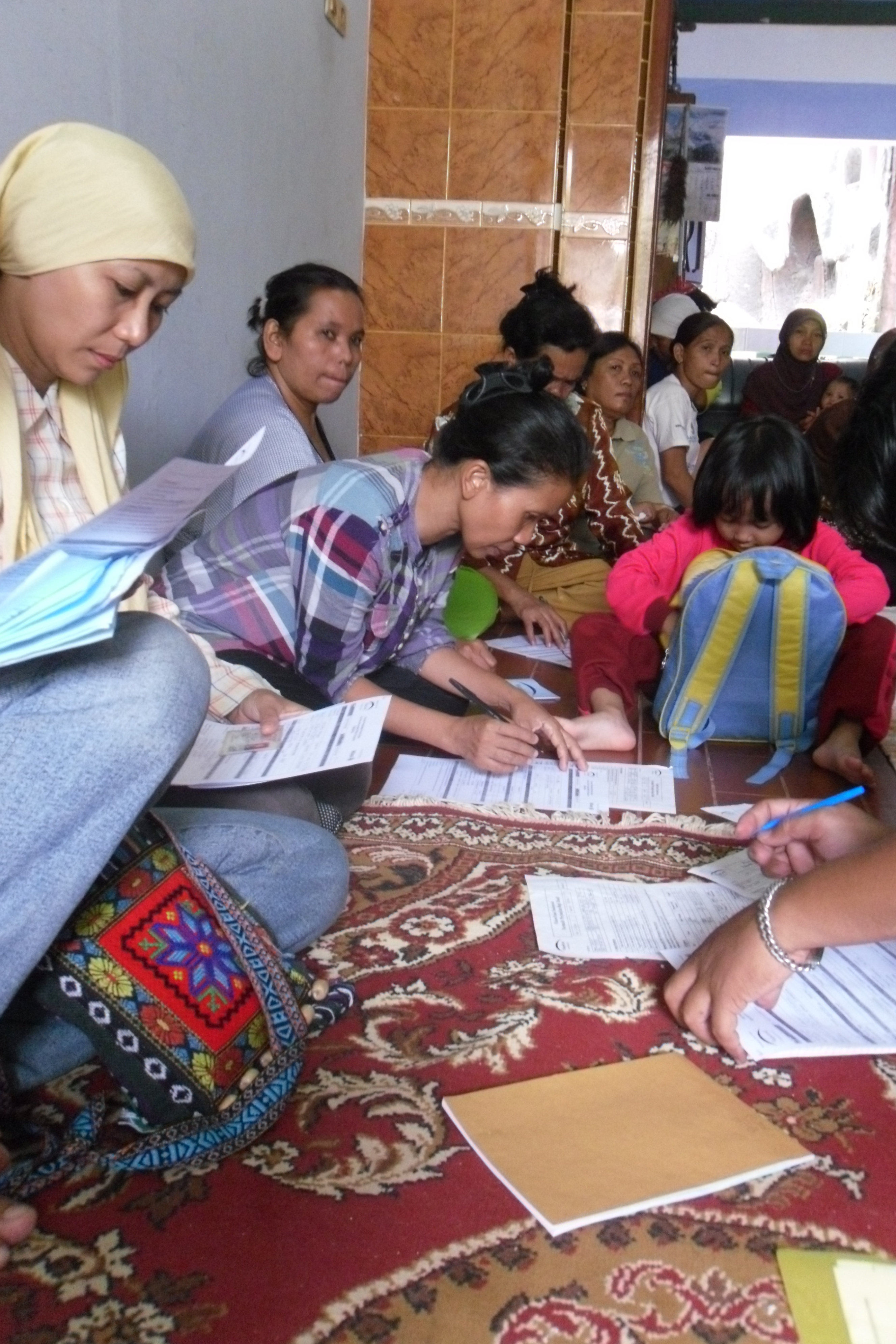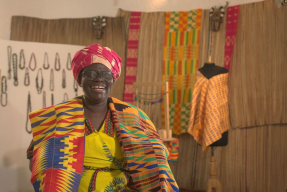Microinsurance in Indonesia: What are the Options for Kiva Borrowers?
November 8, 2011
By Laurie Young, KF 16, Indonesia
According to the World Bank of Indonesia, more than 50% of Indonesians live on less than $2 US per day/per person and more than 80% live on less than $4 US per day/per person. In addition to this, they estimate that greater than one-third of households don’t have access to any formal financial services and microinsurance in the market is negligible. To put this in perspective, the population of Indonesia is estimated at around 245 million and, “in Indonesia today, about one third of the population, or about 77 million people have no financial protection or savings cushion.”
Typical VisionFund Indonesia (VFI) borrowers on their first few loan cycles earn less than $2.50 US per day based on Social Performance Indicators tracked by VFI. So what type of access do VFI Kiva borrowers have to microinsurance in Indonesia? Additionally, what is being done to improve the marketplace as a whole in order to increase access to insurance for the poor? I will try to answer these two questions in this two-part blog. Below, I will focus on the present products being offered by VFI. Next week, after having attended the First Microinsurance Marketplace in Indonesia, I hope to provide further insight into the current challenges facing providers as well as innovations and developments that are evolving in the microinsurance marketplace to help improve the supply of financial services products in Indonesia.
Payung Keluarga (Mandatory Life Insurance)
A VisionFund Indonesia borrower is required to obtain a basic life insurance policy, also known in the market as a ‘Credit Life’ policy. VFI has partnered with Allianz Indonesia to provide this service for the cost to clients of .1% of the loan amount per month. The coverage includes 1) twice the loan disbursement value will be paid to the families of the deceased borrower and 2) the amount of the outstanding balance will be paid to VisionFund Indonesia to cover the remaining debt in the event of death. To put it in monetary terms, if a borrower takes a 6 month loan of 1,000,000Rp (equivalent of around $115 USD) they receive this life insurance policy for the 6 months at a total premium of 6,000Rp, or the equivalent of about 70 cents. If, for example, halfway through the loan repayments the borrower tragically pass away; then their family would receive 2,000,000Rp and VFI would receive 500,000Rp, which is the remaining unpaid principal balance of the loan. The premium is the same regardless of age for anyone between 17 and 60.
One of Allianz’s three goals for their microinsurance activities is to combine corporate social responsibility with a business opportunity. Allianz partners with over 50 MFIs in Indonesia to offer this product, or variations of it. They began offering microinsurance to low-income households in 2006 after a study they completed in cooperation with GTZ (German Technical Cooperation) and UNDP (United Nations Development Program) revealed that there was a huge market of Indonesians without both life insurance and access to obtaining life insurance. At that time, the results of their study estimated that only about 25 million of 238 million Indonesians had life insurance coverage. By partnering with MFIs like VisionFund Indonesia, Allianz can keep their administrative costs very low since the Loan Officers already meet with borrowers for loan paperwork and, at VFI, this insurance coverage has been incorporated into the normal routine.
Tamadera (Optional Insurance)
The second microinsurance/savings hybrid option, “Tamadera”, has been offered to VFI clients since November of 2010. Allianz is currently piloting this product with both VisionFund Indonesia and m-STARS. m-STARS is a unique organization because it originally became “the first company to offer high security compliant mobile banking in Indonesia” in 1999. They are now working with Allianz “to jointly develop micro-insurance products that answer Indonesian rural community needs for micro finance access to increase their living standard and create an economic independent rural community” by allowing the clients to use their mobile phone technology to facilitate more convenient insurance premium payments. More to come on this technology in my next blog. VisionFund Indonesia uses the already-scheduled loan repayment collections as a means to facilitate easy premium payments for their borrowers who have joined the Tamadera program. Rather than making clients pay premiums weekly, they can make payments at times when the loan officer is already visiting them for reasons related to their loan (as long as this schedule wouldn’t make their Tamadera payments more than two weeks delinquent because they could then lose their coverage).
The way Tamadera works is that the client should make weekly premium payments of 10,000Rp (about $1.17) for 50 weeks of the year for five consecutive years. If at any point after they’ve begun Tamadera, they die or suffer from one of the following five critical illnesses, they receive a payment of 2,500,000Rp (around $290 USD).
1. Cancer
2. Stroke
3. Heart attack
4. Kidney failure
5. Major burns
If at the end of the five year insurance term, they have not died or incurred one of the illnesses noted above, clients receive all 2,500,000Rp that they have paid in. This tool is also useful to help educate the importance of savings to borrowers. Any VFI client ages 17-50 can join and there are no administrative fees or medical checkups needed. So, if you are doing the math in your head, you realize that there is no apparent income generated by Allianz to cover the costs from this because every rupiah paid in gets paid back to the client at the end of the five years. Because there is no interest paid to the clients on the ‘savings’, Allianz is able to use this cash to generate some income. You could look at it from the perspective that the clients are foregoing interest in return for insurance coverage. Still, at such a small scale currently, this is not enough to cover Allianz’s costs and payments in case of payouts for illness or death. Currently the Ford Foundation is supporting the Tamadera program with a development grant. The International Labour Organization also just signed on to also provide support by awarding the program a Microinsurance Innovation Grant.
In case you may be wondering why a client would either find this product beneficial or why they would choose not to join, the biggest issue that VFI has seen and heard from borrowers about Tamadera relates to the five-year term. Five years is often too long for borrowers to be able to commit to. Note that clients with Tamadera policies are not committed to maintaining loans for the next five years with VFI in order to stay with the program. They can continue coverage regardless of if they continue to borrow. If the client wants to withdraw their money early and terminate their contract, it is subject to a 15% penalty. However, despite this drawback, some clients like having the option of the insurance/savings because it provides supplementary coverage for diseases in addition to death. Additionally, Indonesian banks with which they may have accounts often charge a minimum 7,500Rp administration fee per month.

Business Development Officer (and Kiva Coordinator), Valentine, helping answer questions about the Tamadera program.
Until last week, none of the Kiva clients had opted in for the Tamadera program. However, during a loan disbursement I attended along with Yoga Prasetyo, Head of Emerging Consumer Business at Allianz, members of two groups have begun the process by filling out the paperwork. If they choose to continue by making their first weekly payments, they could become the first Kiva borrowers with Tamadera. When I spoke with them, some were hesitant because of the five-year commitment while others appreciated having a way to be protected from illness and have an option for savings that was free of fees. Only time will tell how effective this program will be, but years of research and work have already been invested in this product; hopefully it can be successful and help borrowers with tragic life events such as in the next story.
How Tamadera and Payung Kaluarga have already made a difference:
Microinsurance products can help decrease the risk that a death or illness in the family will perpetuate their poverty. In February of 2011, one of VFI’s clients tragically passed away from a heart attack. Sumaiti was a mother of five. She originally had taken a loan for her business selling Bakmi (Indonesian soup with noodles and meatballs). She was one of the first VFI clients who had chosen to join the Tamadera program. Her family received the payment from Allianz for both the Tamedara and Payung Kaluarga. Because of this money, her children had funds to pay school fees and could continue with their education for the time being. It’s programs like these and the work of Allianz and VisionFund that the life of this family was made a little bit easier in the wake of such a tragedy.
_____________
Laurie Young is a Kiva Fellow (KF16) working with VisionFund Indonesia in Jakarta. If you would like to learn more about VisionFund Indonesia, please visit their partner page. You can also support them by joining the lending team for VisionFund Indonesia. Former posts written by Laurie about her experiences in Jakarta and VisionFund Indonesia can be found at:
New City, New Field Partner: Settling into the “Big Durian” (Part 1 of 2)
New City, New Field Partner: Getting to know VisionFund Indonesia (Part 2 of 2)
Meeting Karsinah: Maximizing my Social Return on Investment
Remembering Rizky: VisionFund Indonesia Loses One of Their Own
PREVIOUS ARTICLE
Update from the Field: Earthquakes, 5Ks + The Pain of Sickness and Loss →NEXT ARTICLE
Passport Series: Dominican Republic: Part 1: Country Profile →
















